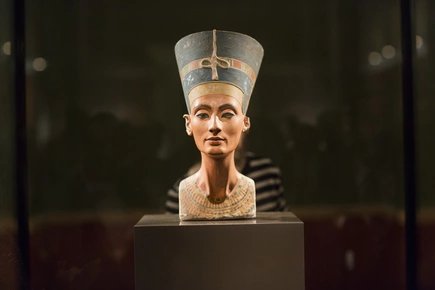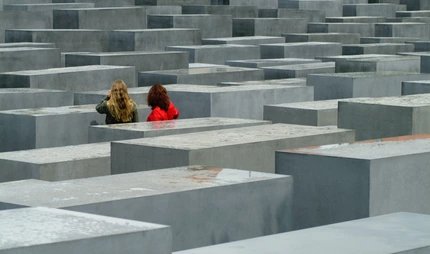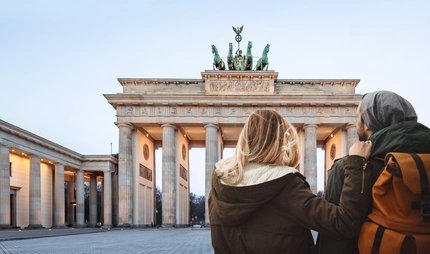
Potsdamer Platz
Typically Berlin – and yet quite different
From an empty wasteland to a popular shopping and nightlife district: Potsdamer Platz in the heart of the city.
Two angels walk across a large grey square, a huge empty wasteland in the middle of the city, with only a wall standing in the middle of nowhere.
If you watch the world-famous 1987 film "The Sky Over Berlin" from the time before the fall of the Berlin Wall and then look at Potsdamer Platz today, you can hardly imagine that it is one and the same place.
A lively new neighbourhood emerged on the former empty space, with only the Berlin Wall running through it after the fall of the Wall in 1989. It is home to restaurants, cinemas, theatres, shopping centres and exciting modern architecture.
Potsdamer Platz today
The term Potsdamer Platz is imprecise. It actually only describes the square next to Leipziger Platz, but it has become customary to use "Potsdamer Platz" to refer to the entire area.
Popular places to shop at Potsdamer Platz and the neighbouring Leipziger Platz, are the big shopping miles The Playce and Mall of Berlin.
To the viewing floor Panoramapunkt in the red-brick Kollhof building, you can whizz up around 100 metres in the fastest lift in Europe. From the top, you not only have a magnificent view of Berlin's skyline. What you get to see is also explained.
The LEGOLAND® Discovery Centre Berlin with around five million LEGO® bricks is great fun for the whole family.
The centre at Potsdamer Platz (former "Sony Center")
A complex of seven steel and glass buildings and a unique tent-like roof construction: this is the centre at Potsdamer Platz, which shines brightly in the evening. It was built by the world-famous German-American architect Helmut Jahn.
The Boulevard of the Stars on the central reservation of Potsdamer Straße in front of the centre is a reminder of great German actors:Inside - and also a little of when the centre still attracted cineastes from all over the world as the focal point of the Berlinale.
This iconic building complex is still worth a visit: in addition to state-of-the-art office space, you will also find plenty of entertainment, shops and gastronomic offerings. Etwa Fredericks, which revives the "bohemian glamour" of times gone by with an upscale restaurant, two bars, lounge and deli.

In the Kerb Food Hall in the former Sony Center, international flavours meet creative street food design. On two floors of the former IMAX cinema, you will find South Korean kimchi, juicy fried chicken, hot tandoor specialities and authentic tacos. The cheese conveyor belt is particularly spectacular, allowing small cheese specialities to glide past the tables like in a sushi restaurant. The range is complemented by sweet desserts, Nepalese dumplings, Moroccan tajines and vegan bowls.
Where the first traffic lights stood: Potsdamer Platz yesterday

The Potsdamer Tor on Berlin-Potsdamer Chaussee, which gave the square its name, has stood there since the 18th century. The square had its heyday at the beginning of the 20th century: traffic was humming and life was bustling here. As early as 1924, the first traffic light system on the continent guided omnibuses, trams, carriages and vehicles. The cultural elite also met in the cafés and restaurants around the square.
The world-famous painting by Ernst Ludwig Kirchner "Potsdamer Platz", which hangs in the Neue Nationalgalerie, gives an impression of the time.
40 years of slumber
The Second World War left behind a devastated square, which then became the "border triangle" between the Soviet, British and American sectors. After the end of the war, the Berlin Wall divided the area, and so Potsdamer Platz spent more than 40 years in a deep sleep - as an urban wasteland between East and West. The Weinhaus Huth was the only undestroyed building standing in no man's land next to the remains of the Hotel Esplanade. At the end of the 1980s, a magnetic railway was installed on Potsdamer Platz along a 1.6 km long route.
The rebirth of Potsdamer Platz
After reunification, a unique opportunity arose to rebuild an entire urban quarter in the centre of a metropolis. The architects Heinz Hilmer and Christoph Sattler won the "Ideas Competition Potsdamer Platz/Leipziger Platz" in 1991. Their concept was based on the model of the "European city", which deliberately decided against a dense high-rise development.
In 1993, construction began on the DaimlerChrysler Quartier according to the masterplan by architects Renzo Piano and Christoph Kohlbecker. It was realised by international star architects such as Renzo Piano, Richard Rogers and Arata Isozaki. In just five years, a new urban centre was created out of nothing on the largest construction site in Europe.
Time travel at Potsdamer Platz: It's worth looking down

If you are at Potsdamer Platz, take a look down, because there a metal strip embedded in the ground reminds you of the course of the Berlin Wall at Potsdamer Platz.
And you can travel back in time directly in front of the Deutsche Bahn Tower: A huge QR Cobble, a digital paving stone, is embedded in the ground. Scan it with the QR scanner in your mobile phone and experience an exciting interactive journey through time with historical panoramic images.
Winter World at Potsdamer Platz

Every year in winter, Potsdamer Platz is transformed into a huge Winter World with Europe's largest toboggan run, an ice rink, curling and a hut with an après-ski party.
Leipziger Platz
Adjacent to Potsdamer Platz is the eight-cornered Leipziger Platz with the elegant shopping centre Mall of Berlin and two popular museums: the German Spy Museum and the Deutschlandmuseum.
The Kulturforum

On the southern side of Potsdamer Platz lies the Kulturforum. Important Berlin museums and institutions are located here:




